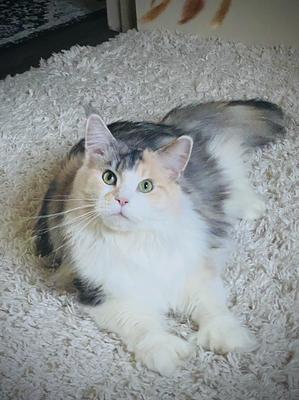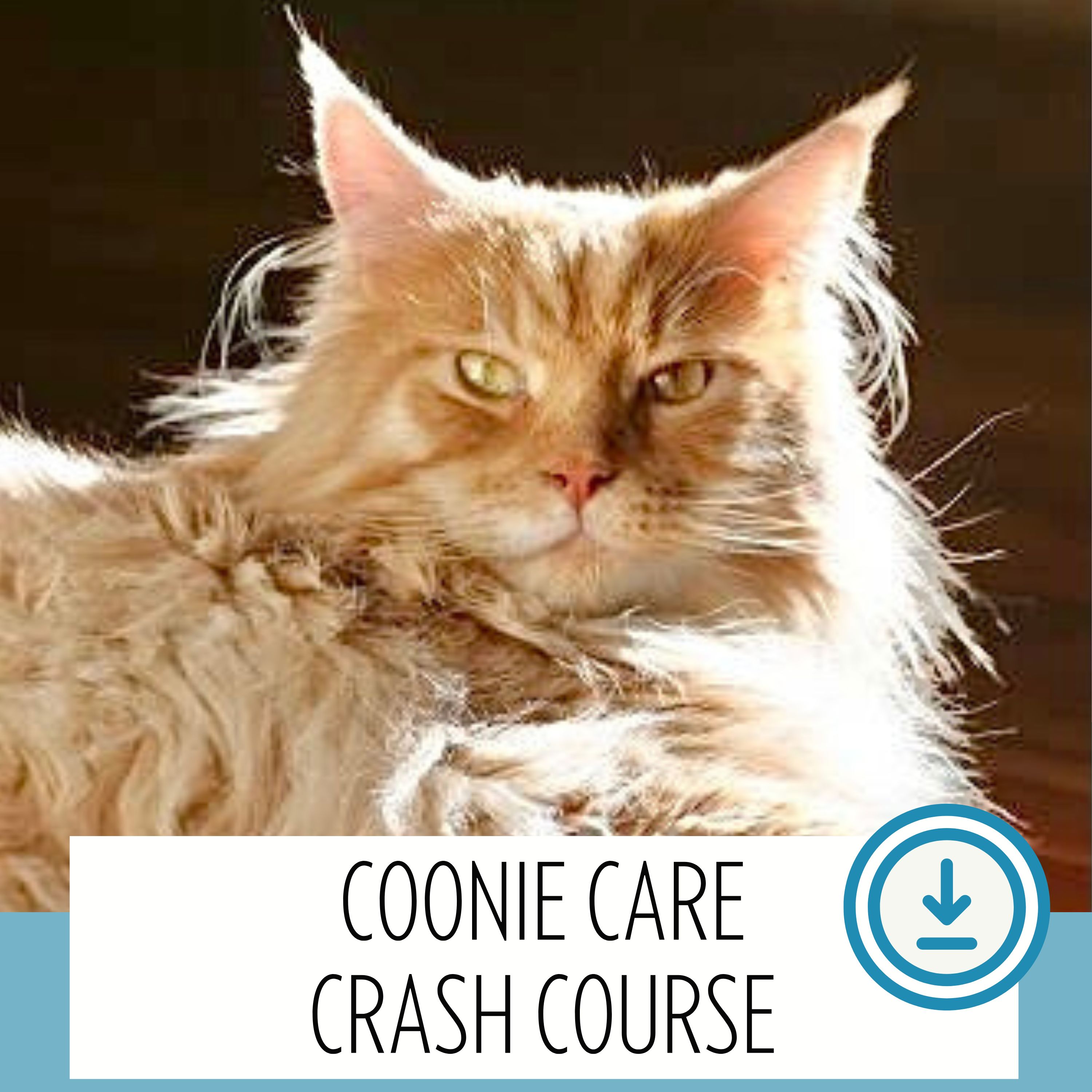Calico Cat Hair Color:
7 Cool Facts About This Pattern
We adore the calico cat hair color! There's so much intriguing information surrounding it, from genetics to cultural beliefs.
Many of our community members share stories and photos of their stunning "Cali" companions. Let’s explore some cool facts!
 Beautiful Calico Maine Coon
Beautiful Calico Maine CoonCalico Cat Facts
1. Calico Isn't a Breed - It's a Color Pattern
 Andrea's gorgeous Molly, from California
Andrea's gorgeous Molly, from CaliforniaWhen people talk about calico cat hair color, they're describing a unique pattern, not a specific breed of cat.
If you read "Calico Maine Coon Cat Breed" - that is incorrect. It's just a coloration!
In fact, this coloration can show up in a variety of breeds!
That gorgeous mix of orange, black, and white you see is simply a result of genetics, not a breed-specific trait.
Unlike tortoiseshell cats (sometimes called money cats) which usually display a blend of black and ginger with minimal white, calico cats are instantly recognizable by their larger patches of these three colors.
It's fascinating to note that this tri-color pattern can be found in breeds like the Maine Coon, American Shorthair, Norwegian Forest cat, and even the Persian.
Each calico has its own one-of-a-kind coat—no two patterns are exactly alike, which adds to their charm!
This variation is what makes them so special. When you see a Calico Maine Coon Cat, you're not just looking at a coat of fur, you're seeing a pattern unique to that individual cat.
Whether you're a fan of long-haired calicos or prefer the short-coated variety, you're bound to fall in love with this fur pattern every time!
2. Calico Cats Are Almost Always Female
 Lacey, showing off her fluffy belly
Lacey, showing off her fluffy bellyOne of the coolest facts about the calico cat hair color is that it's nearly exclusive to female cats.
The reason lies in their genetics. Fur color is tied to the X chromosome, and since females have two X chromosomes (XX), they can carry both the orange and black color genes that make this pattern possible.
Males with calico coats are extremely rare, making up just 1 in 3,000 of these cats. Why? Males typically only have one X chromosome (XY), so they can’t naturally exhibit this combination of colors.
However, when a genetic anomaly occurs, some males are born with an extra X chromosome, resulting in an XXY chromosome pattern. This rare genetic twist allows these males to carry the orange and black fur colors as well.
Unfortunately, most calico boys are sterile due to this chromosomal irregularity, but their rarity makes them even more fascinating.
It's amazing how just one extra X chromosome can lead to such a unique outcome in a cat's coat!
When you spot one, you're witnessing a true genetic marvel in action!
3. No Two Calico Cats Have the Same Pattern
 Bastet has such a unique pattern!
Bastet has such a unique pattern!One of the most mesmerizing aspects of the calico pattern is that it's entirely unique to each cat.
The combination of orange, black, and white patches makes each one as distinct as a fingerprint - no two cats share the exact same coat!
Whether you're looking at a calico Maine Coon with its long, flowing fur or a short-haired domestic shorthair, their patterns are one-of-a-kind.
This individuality applies to all types, including the dilute calico, where the bold orange and black are replaced by softer shades like cream and gray.
Even in these more muted versions, the patches vary in size, placement, and shape, ensuring no two will ever look exactly alike.
Some even have a tabby pattern mixed in, giving them stripes or spots within their colored patches.
These subtle details make each coat a work of art. It’s fascinating to think that, thanks to the complex interplay of genetics, every cat in this color family is truly special.
So, whether you're admiring bright orange or soft cream, you’re looking at a one-of-a-kind masterpiece!
 Fuzzy is a pretty calico
Fuzzy is a pretty calico4. Calico Cats Are Often Considered Lucky
Did you know that these beautiful tri-colored cats are often seen as symbols of good fortune?
In Japanese folklore, the famous Maneki Neko - the "beckoning cat" you often see in shops and restaurants - is usually depicted in this pattern.
The legend says this lucky cat brings prosperity and good luck to its owner, which is why so many businesses display a Maneki Neko figurine to invite success.
But the association with luck doesn't stop there. In many cultures, these cats are considered lucky charms.
Sailors, for instance, used to bring them aboard ships, believing their presence would protect them during long sea voyages and keep the vessel safe from storms.
Here's a fun fact: Because they are so rare and distinctive, especially males, some believe that simply owning one can bring extra good fortune into your life.
Whether you're superstitious or not, it's easy to see why people feel lucky when one of these cats crosses their path - there's something undeniably special about their colorful coats!

5. The Science of The Calico Cat Hair Color: It's All About X-Chromosome Inactivation
 Audrey has lots of black and ginger
Audrey has lots of black and gingerThe tri-colored pattern of these cats is rooted in fascinating genetics, particularly involving the X chromosome.
Female cats have two X chromosomes, which allows for a unique process called X-chromosome inactivation.
Essentially, one of the X chromosomes randomly shuts down in each cell during development.
This means that some cells express the orange fur gene, while others express the black fur gene, creating that stunning patchwork of color we associate with this pattern.
Interestingly, if a male cat has Klinefelter's syndrome—where he has an extra X chromosome (making him XXY)—he can also exhibit this rare color combination.
However, this genetic variation often comes with developmental issues and typically leads to sterility.
The genes that determine fur color can be recessive, meaning they may not show up unless paired correctly.
In the case of female cats, having two X chromosomes allows them to display a combination of colors, making their coats so unique and visually striking.
6. There's a Rare Type: The Dilute Calico
 Molly is a stunning example of the dilute calico coloring
Molly is a stunning example of the dilute calico coloringAmong the different types of calico coloring, one stands out for its softer, more muted look - the dilute calico.
While traditional calicos display bold patches of orange, black, and white, the dilute version features a gentler palette.
Instead of bright orange, you’ll see soft cream. The black becomes a delicate gray, and the white is often accompanied by a peachy hue.
This subdued color scheme occurs due to the presence of the dilute gene, which lightens the pigments in the fur.
Despite the softer tones, these cats still maintain the same distinctive patchwork pattern, just in more pastel-like shades.
They may not stand out as much as their bold-colored counterparts, but their elegant, subtle beauty is equally mesmerizing.
You’ll find this coloration in many breeds, including the calico Maine Coon, where the longer, fluffier fur adds even more charm to their coat color patterns.
Whether vibrant or muted, each coat is entirely unique, making them a true showstopper in any household.
If you're a fan of softer tones, the dilute variation offers an equally captivating alternative to the classic tri-color look.
7. Male Calico Cats: The 1 in 3,000 Phenomenon
When it comes to this striking color pattern, males are a true rarity, making up about 1 in 3,000. The reason for this fascinating phenomenon lies in genetics.
Most male cats have one X and one Y chromosome (XY), while female cats have two X chromosomes (XX). To sport that beautiful tri-color coat, a male needs an extra X chromosome, resulting in a unique XXY chromosome pattern, which is commonly associated with Klinefelter's syndrome.
This genetic anomaly leads to the presence of both orange and black color genes, giving these rare males their distinct look.
However, this chromosomal configuration also comes with health issues and challenges; most males are sterile due to their inactive chromosomes.
This sterility, combined with their rarity, makes them particularly special among cat lovers.
If you happen to come across one of these extraordinary felines, consider it a remarkable find!
 Sisters Natasha and Gretchen
Sisters Natasha and GretchenAs we've seen, the beauty of this color goes beyond its stunning appearance.
From their unique genetic makeup to their cultural significance, these cats are truly fascinating.
Whether you have a Calico Maine Coon Cat home or simply admire them from afar, it's always fun learn about these remarkable felines!
Top of Calico Maine Coon Cat Color
Recent Articles
-
Today's Features
Apr 16, 25 09:54 PM
Today we have two classic Memory Lane pages to share!
Murphy & Candy Cane: Double the Maine Coon Charm - This adorable Maine Coon duo from our 2011 Photo Albums - Murphy and Candy Cane - brought doubl… -
Memory Lane Month Begins!
Apr 15, 25 10:22 PM
We're thrilled to start our "Memory Lane Month" event by visiting some cherished moments from our community! We're in the process of restoring meaningful community stories like this one, to preserve t… -
Will a Maine Coon Protect Its Owner From Danger or an Intruder?
Apr 09, 25 10:41 PM
Plenty of people are curious: Will a Maine Coon protect its owner if something happens? Let’s talk about what this means, and what kind of protector a Coonie is.



